The NVIDIA GeForce GTX 780 Ti Review
by Ryan Smith on November 7, 2013 9:01 AM ESTCompute
Jumping into compute, we’re entering the one area where GTX 780 Ti’s rule won’t be nearly as absolute. Among NVIDIA cards its single precision performance will be unchallenged, but the artificial double precision performance limitation as compared to the compute-focused GTX Titan means that GTX 780 Ti will still lose to GTX Titan whenever double precision comes into play. Alternatively, GTX 780 Ti still has to deal with the fact that AMD’s cards have shown themselves to be far more competitive in our selection of compute benchmarks.
As always we'll start with our DirectCompute game example, Civilization V, which uses DirectCompute to decompress textures on the fly. Civ V includes a sub-benchmark that exclusively tests the speed of their texture decompression algorithm by repeatedly decompressing the textures required for one of the game’s leader scenes. While DirectCompute is used in many games, this is one of the only games with a benchmark that can isolate the use of DirectCompute and its resulting performance.
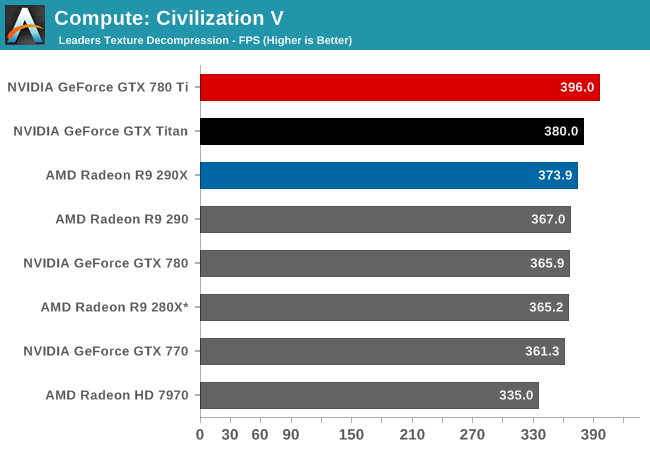
Even though we’re largely CPU bound by this point, GTX 780 Ti manages to get a bit more out of Civilization V’s texture decode routine, pushing it to the top of the charts and ahead of both GTX Titan and 290X.
Our next benchmark is LuxMark2.0, the official benchmark of SmallLuxGPU 2.0. SmallLuxGPU is an OpenCL accelerated ray tracer that is part of the larger LuxRender suite. Ray tracing has become a stronghold for GPUs in recent years as ray tracing maps well to GPU pipelines, allowing artists to render scenes much more quickly than with CPUs alone.
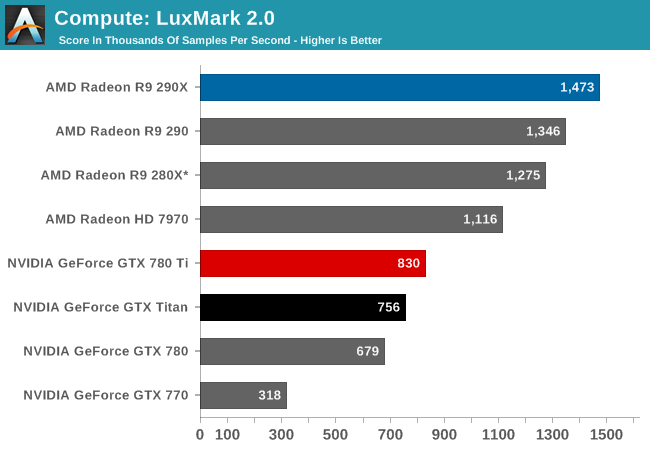
With LuxMark NVIDIA’s ray tracing performance sees further improvements due to the additional compute resources at hand. But NVIDIA still doesn’t fare well here, with the GTX 780 Ti falling behind all of our AMD cards in this test.
Our 3rd compute benchmark is Sony Vegas Pro 12, an OpenGL and OpenCL video editing and authoring package. Vegas can use GPUs in a few different ways, the primary uses being to accelerate the video effects and compositing process itself, and in the video encoding step. With video encoding being increasingly offloaded to dedicated DSPs these days we’re focusing on the editing and compositing process, rendering to a low CPU overhead format (XDCAM EX). This specific test comes from Sony, and measures how long it takes to render a video.

Like LuxMark, GTX 780 Ti once again improves on its predecessors. But it’s not enough to make up for AMD’s innate performance advantage in this benchmark, leading to GTX 780 Ti trailing all of the AMD cards.
Our 4th benchmark set comes from CLBenchmark 1.1. CLBenchmark contains a number of subtests; we’re focusing on the most practical of them, the computer vision test and the fluid simulation test. The former being a useful proxy for computer imaging tasks where systems are required to parse images and identify features (e.g. humans), while fluid simulations are common in professional graphics work and games alike.
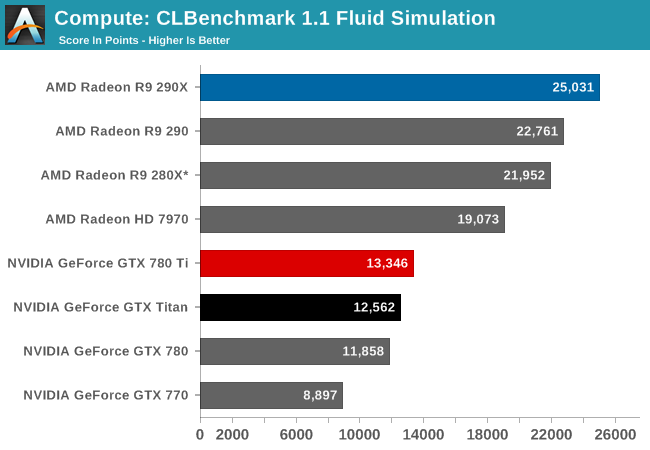
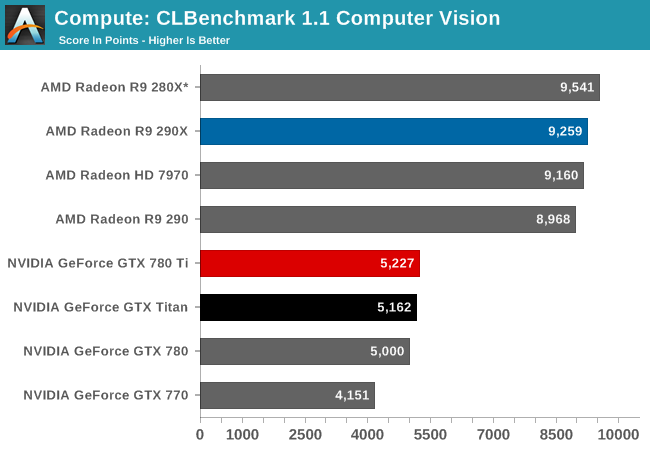
CLBenchmark continues to be the same story. GTX 780 Ti improves on NVIDIA’s performance to become their fastest single precision card, but it still falls short of every AMD card in these tests.
Moving on, our 5th compute benchmark is FAHBench, the official Folding @ Home benchmark. Folding @ Home is the popular Stanford-backed research and distributed computing initiative that has work distributed to millions of volunteer computers over the internet, each of which is responsible for a tiny slice of a protein folding simulation. FAHBench can test both single precision and double precision floating point performance, with single precision being the most useful metric for most consumer cards due to their low double precision performance. Each precision has two modes, explicit and implicit, the difference being whether water atoms are included in the simulation, which adds quite a bit of work and overhead. This is another OpenCL test, as Folding @ Home has moved exclusively to OpenCL this year with FAHCore 17.

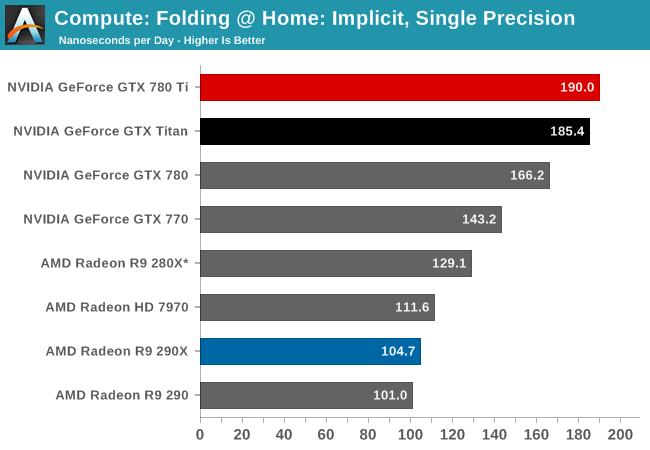
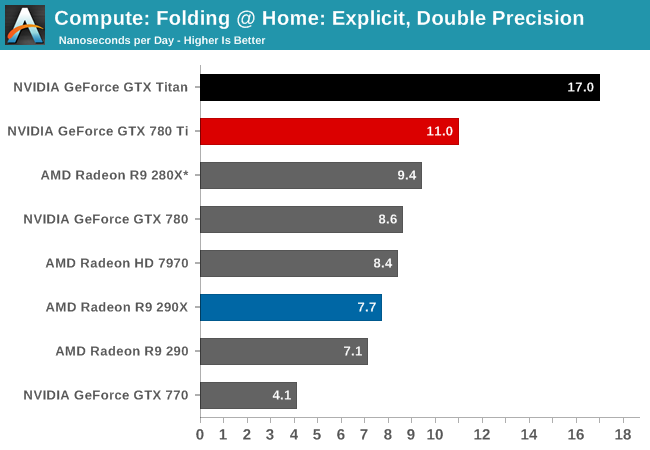
Finally with Folding@Home we see the GTX 780 Ti once again take the top spot. In the single precision tests the GTX 780 further extends NVIDIA’s lead, beating GTX Titan by anywhere between a few percent to over ten percent depending on which specific test we’re looking at. However even with GTX 780 Ti’s general performance increase, in the double precision test it won’t overcome the innate double precision performance deficit it faces versus GTX Titan. When it comes to double precision compute, Titan remains king.
Wrapping things up, our final compute benchmark is an in-house project developed by our very own Dr. Ian Cutress. SystemCompute is our first C++ AMP benchmark, utilizing Microsoft’s simple C++ extensions to allow the easy use of GPU computing in C++ programs. SystemCompute in turn is a collection of benchmarks for several different fundamental compute algorithms, as described in this previous article, with the final score represented in points. DirectCompute is the compute backend for C++ AMP on Windows, so this forms our other DirectCompute test.
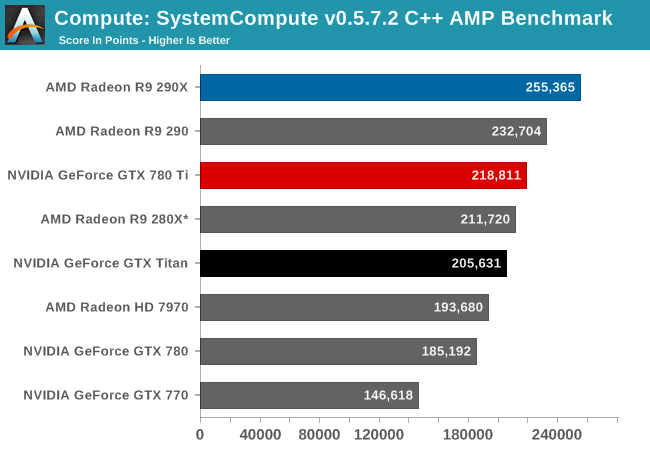
Last, in our C++ AMP benchmark we see the GTX 780 Ti take the top spot for an NVIDIA card, but like so many of our earlier compute tests it will come up short versus AMD’s best cards. This isn’t quite as lopsided as some of our other tests, however GTX 780 Ti is stuck competing with the 280X while the 290 and 290X easily outperform NVIDIA’s new flagship.










302 Comments
View All Comments
HisDivineOrder - Thursday, November 7, 2013 - link
Sure, you can save money by buying into the R9 290X, but save that money because you're going to need it in a few years for a hearing aid.OverclockedCeleron - Thursday, November 7, 2013 - link
As if there won't be any custom-cooled R290X-based GPUs. You make it sound like all GPU vendors and partners have abandoned AMD, and that AMD is going to be stuck with that fan forever. Well done for being short-sighted.HalloweenJack - Thursday, November 7, 2013 - link
[img]http://assets.diylol.com/hfs/8fa/d87/4bb/resized/y...[/img]halo37253 - Thursday, November 7, 2013 - link
Personally I find it Kinda sad given the Fact that GK110 is a much bigger chip in general it would have a bigger lead at stock. Plus powerusage while gaming goes back and forth with the titan, it is competing with. Nvidia just has more aggressive TDP throttling, while AMD's is mainly temp based.290x is only hot under stock cooler, It actually runs pretty cool under water. Also 290x is doing more with less transistors compared to Nvidia. Sucks Nvidia needs to scale Kepler to such a higer level just to compete with AMD's lower offerings. AMD would slaughter Nvidia with a Die of equal size.
Also with the 290 being $399 Nvidia is boned, unless the drop the gtx780's price again. 290 @ 1300mhz is about the same as a 780 @ 1400mhz.
G-Sync only works with one monitor so far, and considering I already have a 120hz monitor and already get a taste of wants to come I could care less. We won't see it in anything not overpriced for years to come, by that time we will probably have a open standard that both Intel and AMD can use. Plus I want a 1440p ISP with G-Sync and doubt that will happen any time soon. Mantle is by far a more interesting option if you ask me. I already with with vsync off and get no tearing and games are as smooth as ever with AMD's current drivers. Smoother then my old Nvidia card, though I just made the switch to AMD and never really had the chance to use the old "crap" drivers.
fewafwwaefwa - Thursday, November 7, 2013 - link
foad cretin.fewafwwaefwa - Thursday, November 7, 2013 - link
hope you get your stomach disemboweled.fewafwwaefwa - Thursday, November 7, 2013 - link
I'd gladly saw your head open.Samus - Friday, November 8, 2013 - link
The problem with this card is the 25% price premium over AMD's 290X for 11% more performance.The only real advantage it has over the 290X is lower noise. Other than that it lacks next-gen optimizations (Mantel, EA partnership, console ports, etc.)
ahlan - Friday, November 8, 2013 - link
http://s11.postimg.org/odh7byx3n/amd_N.pngLol most review site are Nvidia's bitch....
tcube - Friday, November 8, 2013 - link
erm... 290x in uber mode is edged by what? 1-5%... I can't call this a win + GK110 has reached it's full potential. And 780Ti is basically an excelent GK110 chip castrated and sold for 700$ instead of the regular 4k$ (K6000) + they pushed GDDR5 to it's maximum to just edge the 290x... I don't know... This thing looks like vapor ware, let's see some availability but I doubt it's ok for nvidia to sell a perfectly good chip for what? 6 times less? Plus the last tests with 290 without the x show that 290x has lots of potential leftHow I see it 290x was rushed to market and suffers because of it bad cooler, high temperatures and slow memory... 780ti is the best of the Kepler architecture Oc'ed both memory & gpu with basically a pro grade chip and 30% more diespace and it just barelly edges out the 290x in uber mode.
What AMD managed is to make nvidia divert perfect GK110's from pro line to mainstream and shifted their focus - which is a bad thing to do atm for nvidia. And nvidia reacted like a... fanboy really by scrambling to bring a lab rat on the market... just to barely claim the crown back... instead of focusing on maxwell and pro line improvements... They really behaved like little kids with ADHD with this one... but ... oh well...